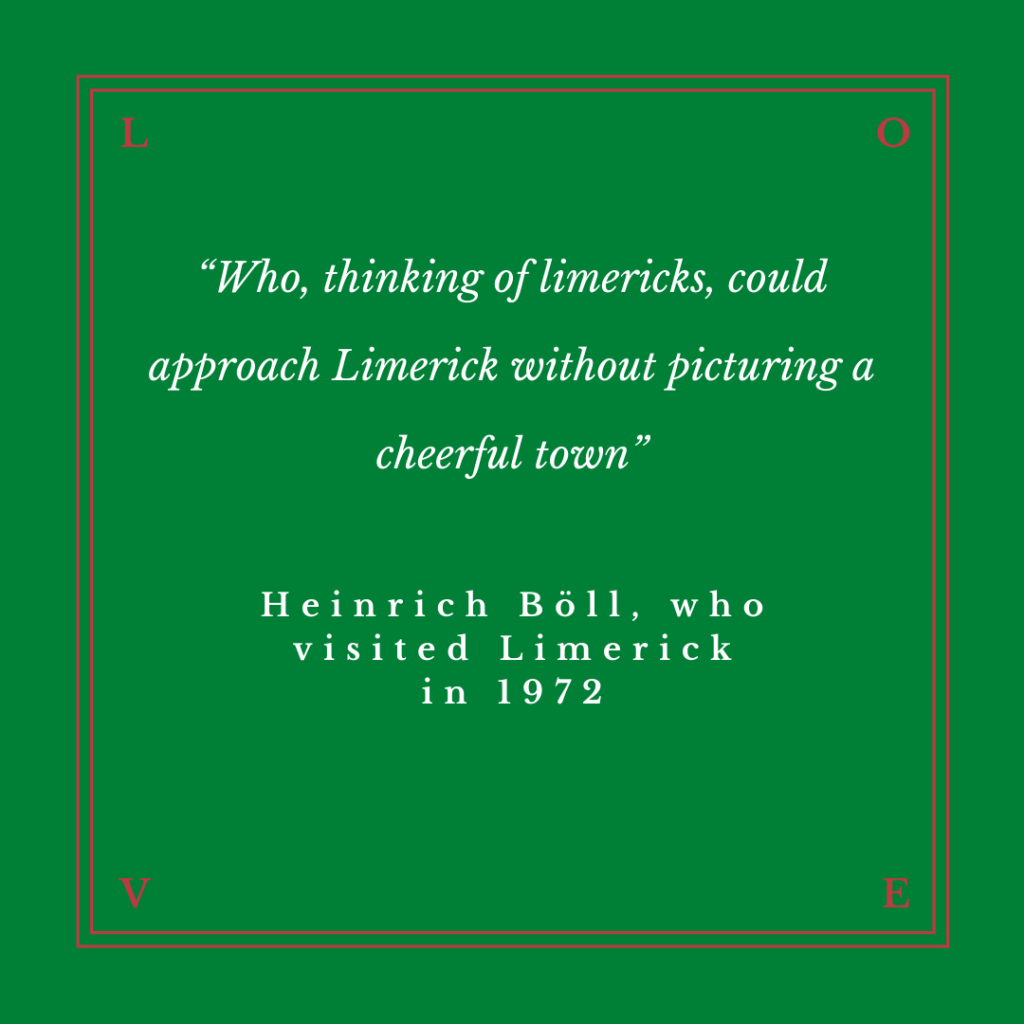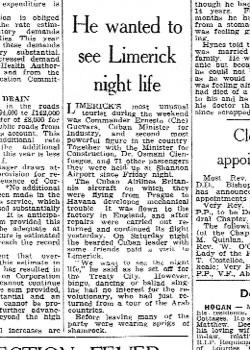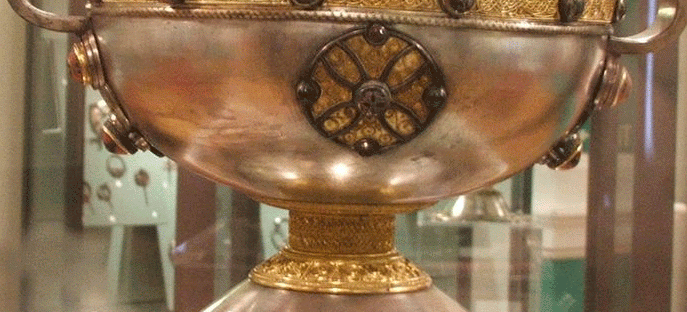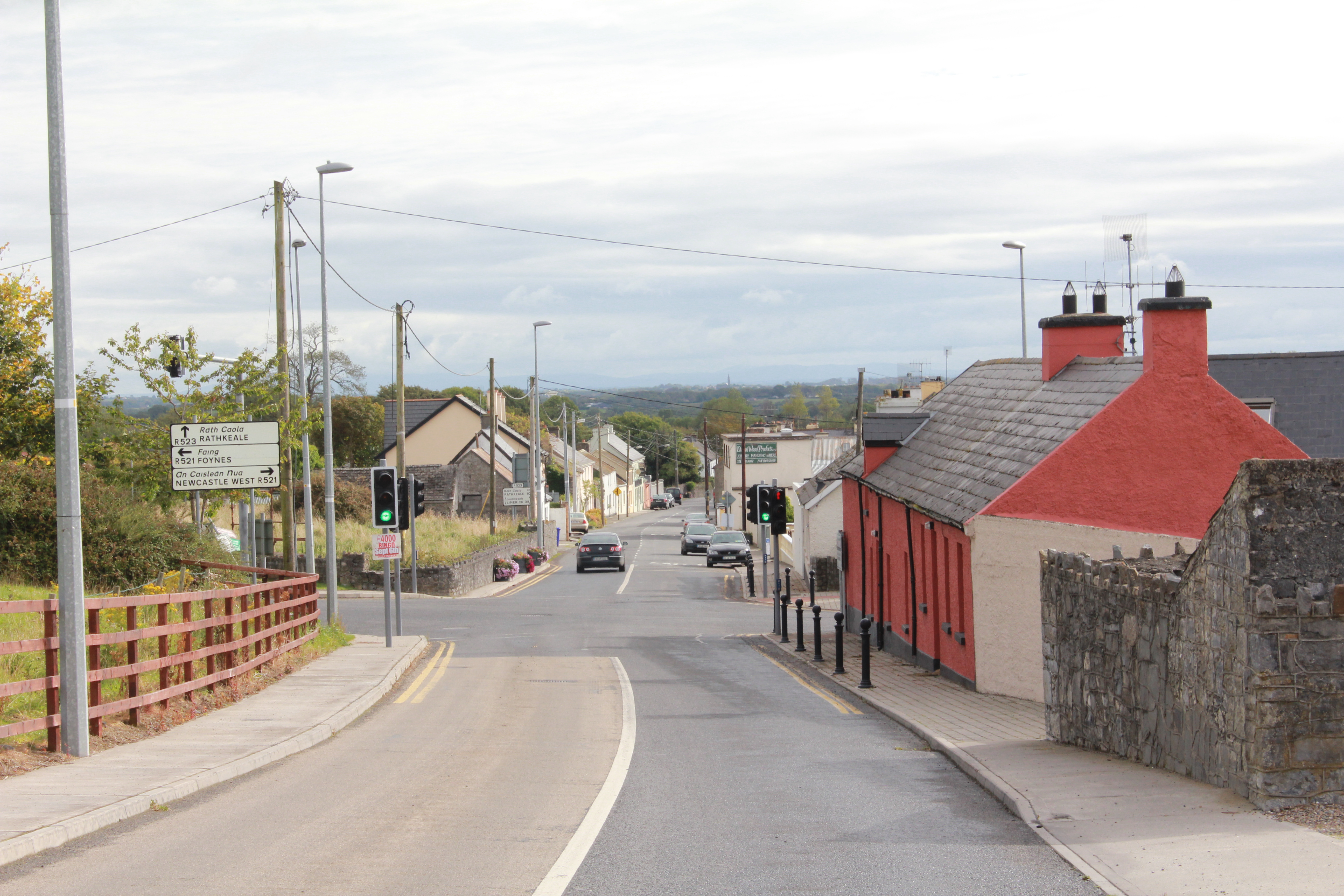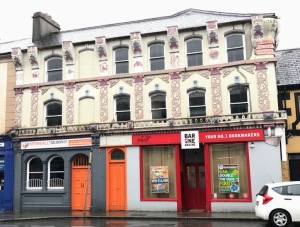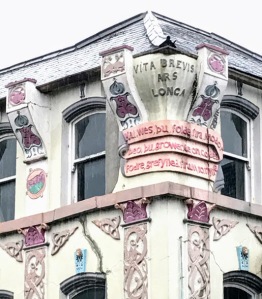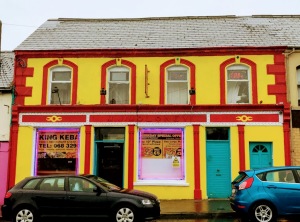Some months ago, I wrote about Pat McAuliffe (1846-1921), the stucco and architectural artist who lived and worked in Listowel, Co Kerry, and his decorative stucco work in Listowel. I had walked through the streets of Listowel, and had been enthralled by his hotel façades, detailed shopfronts and pub decorations.
His work is a wonderful and eclectic mixture of classical, art nouveau, Celtic and Byzantine influences. They are important examples of the late 19th century pan-European quest for a national style, and they remind me of the style of stucco work by my great-grandfather, James Comerford (1817-1902), at the Irish House on Wood Quay and the Oarsman in Ringsend, Dublin.
But there are significant examples of Pat McAuliffe’s work too in Abbeyfeale, Co Limerick, and recently I spent a rainy but enthusiastic afternoon there exploring the surviving parts of his work.
From the early 19th century, Abbeyfeale – like Listowel – grew in importance and expanded as a market town and commercial centre. A new Market Square was laid out, with new streets leading off it, and the building trades found a new demand for their skills.
In Abbeyfeale, Pat McAuliffe plastered and roofed many of the new buildings in New Street, and he renovated shopfronts and pub-fronts, embellishing them with his decorative stucco work.
McAuliffe’s most extravagant and best-known work in Abbeyfeale was at O’Connor’s on Main Street. This building was an example of how Abbeyfeale grow as a business town in the 19th century. The original building was probably erected in the 1850s, and originally housed the family townhouse, with a drapery shop and a branch bank at ground-floor level. In time, it came to accommodate a drapery, public house, grocery, hardware, builders’ suppliers.
Large-scale renovations were carried out in 1905-1910, and McAuliffe probably did not work on the ground floor, where there was already a large shopfront, an entrance to the family residence and a pub-front.
Instead, McAuliffe worked on the two upper floors, where his stucco decorations are eye-catching and riotous.
The first floor has nine pilaster-style strips with inter-lacing Celtic designs that are mainly interspaced by the windows, while the second floor has ten large imposts that, along with the window keystones, are decorated with animals, Biblical allegories, including a mammoth, a wolf, a frog, a peacock, Eve in the Garden of Eden, a dove elephants and lions’ heads.
A Latin aphorism and an Anglo-Saxon blessing on O’Connor’s on Main Street (Photograph: Patrick Comerford, 2017)
The focal point of McAuliffe’s work is found at the corner of the top floor, which he decorated with a segmented curved mass. In bold clear lettering, a Latin citation stands out: Vita Brevis Ars Longa – ‘Life is short, art is long.’ This is a Latin version of an aphorism originally in Greek, quoting the first two lines of the Aphorismi by the classical Greek physician Hippocrates:
Ὁ βίος βραχύς,
ἡ δὲ τέχνη μακρή,
ὁ δὲ καιρὸς ὀξύς,
ἡ δὲ πεῖρα σφαλερή,
ἡ δὲ κρίσις χαλεπή.
Life is short,
and art long,
opportunity fleeting,
experimentations perilous,
and judgment difficult.
The familiar Latin translation quoted by McAuliffe reverses the order of the original Greek lines. In plainer language, Hippocrates is saying: ‘It takes a long time to acquire and perfect one’s expertise and one has but a short time in which to do it.’
Below this, McAuliffe has a three-lined scrolled text that reads:
Hal, wes bu, folde, fira modor Beo, bu, growende on Godes ferfine Fodre grefylled, firum to nytte
This is said to be a 10th century Anglo-Saxon agricultural charm, and has been translated:
Hail to thee, Earth, Mother of men!
Be fruitful in God’s embrace
Filled with food for the use of men.
McAuliffe placed an angel on the corner above the texts, but this has been removed in recent decades. The upper floors now show signs of neglect, with layers of paint peeling away from the façade, although much repainting and repair work was carried out on this majestic building in 2004.
McAuliffe turned the former Georgian shopfront at JD Daly’s into a typical expression of his tastes in decoration (Photograph: Patrick Comerford, 2017)
JD Daly’s is a three-storey, two bay building on Main Street, Abbeyfeale, that was a public house, grocery shop and guesthouse, first built in 1853 on Georgian architectural principles.
McAuliffe’s expressive work on this building dares from about 1890 and included Corinthian capitals, Egyptian gorge moulding, arabesque features, Latin scrolls, Hiberno-Romanesque bearded men, lions’ heads, and Italian diamond-pointed quoins.
When the gable end was replastered in the 1960s, it meant the destruction of an embellished text on a curved scroll that quoted the motto on the great seal of the United States: E Pluribus Unum.
Two, large Byzantine urns that once crowned the façade – one at each side of a large bracketed cornice – were removed in the1970s, supposedly for insurance reasons. In more recent years, Daly’s former pub has become a drapery shop, and then a private residence, resulting in the loss of McAuliffe’s fascia board.
Tangle’s was once a pub and retains much of McAuliffe’s work (Photograph: Patrick Comerford, 2017)
Tangle’s Hair Salon on Main Street is a former pub that has retained its render quoins, a decorative sill band, window surrounds and pilasters. The elaborately decorated shopfront demonstrates the influence of classical design ideas on McAuliffe’s work, and he used the pilaster as an economic substitute for cut stone.
McAuliffe’s work can be seen on Fuchsia Hair Design on Main Street, (Photograph: Patrick Comerford, 2017)
McAuliffe was possibly also the stucco artist who decorated the premises now known as Fuchsia Hair Design on Main Street, with its large amount of render decoration to the façade. There are heavily-rusticated quoins coupled with a dentilated cornice and interlacing motifs that create a striking composition.
McAuliffe’s work at Cryle’s is an eclectic mixture (Photograph: Patrick Comerford, 2017)
Cryle’s Dry Cleaners and Laundrette on New Street was built as O’Mara’s public house. This is a two-storey, three-bay building, and McAuliffe’s work on the façade was an eclectic mixture of exaggerated classical detailing, combined with Celtic, Byzantine and Middle Eastern influences.
The Byzantine influences are seen in the eight urns, each topped with a cross. The first storey is framed by pilaster strips of Celtic tracery, each topped with foliated capitals designed by McAuliffe himself. The three windows on this floor are linked with large moulded bands, and above these bands is a pair of radiating starbursts, flanked on the outside by interlaced Stars of David.
When the building was replastered in 1990s, the fascia detailing was lost along with the ground-floor pilasters with their interlacing strapwork.
At MJ Moloney’s, McAuliffe was influenced by Classical Revival styles (Photograph: Patrick Comerford, 2017)
At the former MJ Moloney’s pub on Church Street, now a takeaway food shop, McAuliffe’s work was influenced by Classical Revival styles, and the designs for the shopfront includes plants and circular motifs enlivening the frieze.
There are more premises throughout Abbeyfeale that seem to be McAuliffe’s work, or that were influenced by his stucco art. I may need to return on a sunny afternoon this summer to see if I can identify them.
